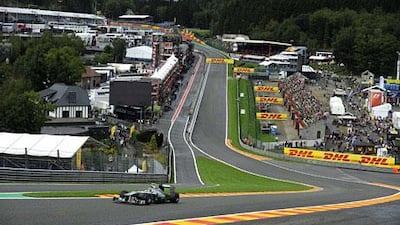Pick up some earplugs: we are going for a walk. And you might want to grab a waterproof jacket too. And some sunglasses. The Belgian weather is as predictable as the flightpaths of the wasps which plague this paddock.
Without a photographer's tabard, the optimum place for me and you to watch Formula One drivers battle the Circuit de Spa-Francorchamps is at the foot of the GP2 pit-lane exit, so it is there we shall head.
From our position, beside the thin metal crash-barrier, we can see the likes of Michael Schumacher, who started his illustrious career at the Belgian Grand Prix 20 years ago, fight with the undulations and inclines of the calendar's most capricious track - as well as its most renowned corner.
You, my friend, may already recognise Le Raidillion de l'Eau Rouge. You probably saw it as you arrived at the circuit this morning, although it is possible you considered it significantly too steep a corner for an F1 car to negotiate.
Or perhaps the peak of "the wall" was enveloped in the Ardennes region's mystical mist. Either way, you can see it now in all its glory: the short downhill straight, a sudden change of direction at the bottom and then a mammoth climb into the clouds.
"From the cockpit, you cannot see the exit and as you come over the crest, you don't know where you will land," said Fernando Alonso, Ferrari's Spanish driver.
"It makes a special impression every lap, because you also have a compression in your body as you go through the bottom of the corner."
Prepare yourself to also experience a feeling of compression because, despite the earplugs, the rasping, violent roar of a V8 engine can pervade the little buds of orange foam and make your head feel like it has been cramped in a vice. Imagine being gifted a haircut from a jet-plane's propeller.
It is terrifying and terrific and perfect proof of why there is such opposition to the introduction of lesser capacity V6 configurations from 2014. You will love it.
"Throughout the race, and particularly at the start, the sight of the cars screaming down from T2 into Eau Rouge, twitching as they go through the corner is, for many fans, the essence of F1," wrote Team Lotus in their track preview.
It is these visceral noises and the panoramic views that see the spectators in the stand opposite to where are will be willingly paying in excess of €450 (Dh2,370) for one of the season's most expensive seats.
Yet if Jerome D'Ambrosio - Belgium's sole representative - speeds past and drops a gear ahead of the hill, you will notice the majority of the fans adorn not the Belgian tri-colour but rather McLaren red and Ferrari rouge.
Such observations will likely trigger a train of thought that makes you wonder where the corner got its name, but you would be altogether wrong to associate team affiliations with track appellations.
Let me explain it for you: Eau Rouge is so called for it is the first point of the 7km track where it crosses the Eau Rouge stream - a 15km waterway that flows through Liege.
The river itself earned its name due to the crimson clay that line its banks and add a scarlet colouring to the water. We can have a look later, if you like, although we may not need to.
Courtesy of the wet Belgian weather that comes and goes and ebbs and flows, at times it can appear the track itself has a stream running through it.
With a puddle gathering at the foot of the climb, the majority of drivers tend to drop a gear during practice sessions rather than take it flat-out, but during tomorrow's race that is likely to change regardless of conditions.
"You are afraid because you know you have to go full out," said Pierre-Alain Thibault, a former driver and now the general manager at Circuit de Spa-Francorchamps. "Your heart beats faster and you tell yourself a normal person would never do it flat-out, but I will.
"At the moment you enter the corner, you get an instant pleasure because it is dangerous, difficult to negotiate and your adrenalin level is at its highest.
"It is incredible."
Watching from a distance close enough that your fingers will rattle from the vibrations on the barrier, you should also feel the danger and adrenalin. Had Paul Di Resta crashed at Eau Rouge instead of Turn Nine - or were a piece of a car to break off and hit us - we would drop quicker than a pine needle.
At this stage, with those thoughts fresh in your mind and with a red flag calling a halt to the on-track action, you might decide you have seen enough, but you should not let morbid dreaming put you off: the recovery truck will likely trundle along on its way to Di Resta and watching it as it struggles to mount the immense incline is always worth hanging around for.

